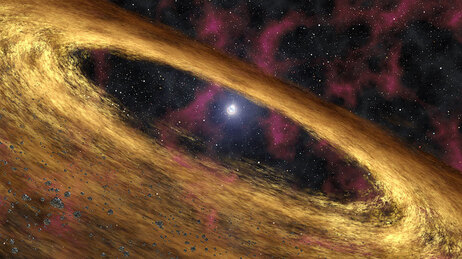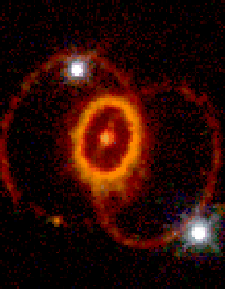Rocks aren't alive. Life is.
So think of them as separate. Rocks over here; life over there.
Then along come Robert Hazen and his colleagues with their study, "Mineral Evolution," published in the American Mineralogist and all of a sudden categories shatter. I'm amazed. I hadn't thought of this, even remotely.
Here's what they found:

A SUPERNOVA thanks to Hubble...

This Hubble Space Telescope photograph shows supernova, 1987A, with its three rings. Material from the explosion has begun to hit the inner ring.
This explosion happens because the center, or core, of the star collapses in less than a second. The outer layers of the star are blown off in the explosion, leaving a contracting core of the star after the supernova. The shock waves and material that fly out from the supernova can cause the formation of new stars. There are many beautiful images of supernova remnants, the expanding shell of gas made up of the outer layers of the original star.
Supernovae last one or two years, and can shine brighter than a whole galaxy for this time. What happens to the star after the supernova depends on how big it was to begin with. If the star was only a few times bigger than the Sun, the core will shrink into a tiny neutron star only a few miles across. If the star was much bigger than the Sun, the core will shrink down to a black hole.
A typical neutron star is the size of a small city, only 10 Kilometers in diameter but it may have the mass of as many as three suns. It is quite dense. One spoonful of neutron star material on Earth would weigh as much as all the cars on Earth put together.Now that's HEAVY!
States of matter.
This figure shows the four common states of matter: solid, liquid, gas, and plasma.
Consider water as an example. Solid water is ice. Liquid water is, well, water. We call water in its gaseous form "water vapor". A plasma created from water would include electrons, protons (hydrogen atom nuclei), and oxygen atom nuclei (protons and neutrons).
There are special names for most transitions from one state to another. Freezing is turning from a liquid to a solid; melting is turning from a solid to a liquid. The transition from liquid to gas can happen by boiling or evaporation. Condensation is changing from a gas to a liquid. Sometimes (usually at low pressure) a solid can become a gas directly (without first melting to become a liquid); this transformation is called "sublimation". Removing electrons from atoms (usually in a gas) to produce a plasma is called "ionization".
Stars are made of plasma, so plasma is the most abundant form of matter in the universe.
There are several other very exotic and unusual forms of matter that we don't encounter in daily life. A Bose-Einstein condensate can only form at temperature near absolute zero, and was first created in a lab in 1995. Degenerate matter can come into being under incredibly high pressure inside white dwarf and neutron stars. There are other very strange, very rare forms of matter as well.
Run through this over view of "matter"- take notes
Now go to STRANGE MATTER

What do you think?

WOAH!!! Thanks Mr.V that awesome!!!
ReplyDeletePaul
Yellow
I didn't know that life effected nonliving things like that. thats really cool!
ReplyDeleteHunter
Yellow
wow thats amazing!
ReplyDeleteI never new that. That is so cool.
ReplyDeleteAllie Yellow
Mr.V this ties in with my scientist Tycho Brahe. This is so cool. Maybe we can put this into our presentation (info above). That's a super nova right? Can we use this picture in our presentation?
ReplyDeleteKaitlyn and Allie Yellow
(We both came up with these questions.)
Mrs V found this for me... she says she would be proud for you two to use this in your presentation ... she may want to see what you do.
ReplyDeleteNOW THAT'S COOL!
But Mr. V, is it a supernova?
ReplyDeleteYellow Kaitlyn
The picture is of a Pulsar -- the after affect (sometimes)
ReplyDeleteMr.V I have a few questions. On the few worksheets from 10/21 I can't figure out how I got the wrong answers on page 7 number 10 and 11. The next page, page 9 number 3 and the speedometers. Page 10 number 6. This is all from a while ago but I really can't figure them out.
ReplyDeleteAllie Yellow
Makes Sense. I heard that some people have a small amount of Iron in their noses.
ReplyDelete-Justin, Blue
Justin, Iron is the essential requirement of a Human body. It is a part of many proteins and enzymes that help in efficient functioning of human body. The most important protein of all is Haemoglobin which is responsible for movement of oxygen around the body. It also controls cell division and growth..
ReplyDeleteNot certain about their "noses"....?
Mr. V i have a question about my presentation tomorrow, it has to be 3 to 5 minutes right?
ReplyDeleteIt should be between 3 and 5 minutes with only a few questions to follow... is that a problem?
ReplyDeleteNo it is not, that won't be hard.
ReplyDeleteTell Mrs V I said thank you for the supernova picture!!!!!
ReplyDeleteKaitlyn Yellow
Mr. V, I signed up to do my presentation Tuesday but i forgot that I have to go to a field trip for chorus! Im sorry and can I present my project on Wednesday first? Please let me know! Thank you (:
ReplyDelete-Lindsey
Green
OK Lindsey... no worries
ReplyDeleteHi Mr V. Thanks for responding to my email btw. I have a question about my presentation. I have used about 5 or 6 sources. I have taken info out of each of those sources and I have the original biography I had to re-check out. I have read that book but did not use much info from it. Do u still want me to bring that in??? Because remember I had done a lot of note cards and I used bits and pieces out of them. Can u help me out?
ReplyDeleteTyler/Grenn
I dont think my message sent out? I just need an answer before i fall asleep.
ReplyDeleteThanks
Tyler
Tyler, Don't worry about it. Bring what you have, its plenty.
ReplyDeleteReviewing Key Concepts
ReplyDelete1. a. Solids have definite shapes and definite volumes. b. Crystalline solid particles form a regular, repeating pattern and melt at a distinct temperature; amorphous solid particles are not arranged in a regular pattern and melt over a range of temperatures. c. Glass is an amorphous solid. Because glass does not have a definite melting point, it becomes softer and softer as it is heated. This is why heated glass may be soft enough to bend.
2. a. Liquids do not have definite shape, but do have definite volume. b. Because its particles can move freely around one another, a liquid takes the shape of its container. Because its particles are packed closely together, a liquid has a definite volume. c. Due to surface tension, a needle can float on the surface of water; the surface of the water acts like a sort of skin.
3. a. The shape and volume of a gas are the same as those of its container. b. A gas has neither definite shape nor definite volume because its particles spread apart and move freely in all directions, restricted only by the wall of its container.
Page 75 Chapter 3 PHYS SCI
I went on the strange matter web site I really liked the part with the crusher show which can stand the most presure like aluminum vrs pinewood and concrete fasing a type of ice that was made for world war 2. so all in all I liked the web site and seeing things get smushed
ReplyDeletethanks Jake Yellow
WOW! That really helps me understand more about plasma. I had a pretty good grasp on the other states of matter, but I didn't understand plasma.
ReplyDeleteLarry
Yellow
Larry, I am glad it helps. Was there any one specific part that did it for your? Tell others about it too.
ReplyDeleteThanks,
put a point(1) in the bonus box.
Jake,
ReplyDeleteI'm sort of a "smush it" fan myself. There are some other sites with similar things going on.
Feel free to look around and search the archives.
Put a point(1) in the bonus box.
Thanks for the answers on pg.75
ReplyDelete-Janki/blue
Mr.V I totally forgot to read this blog before I read the chapter. That was so stupid of me. I was having a tricky time with plasma, and now I have better understanding . Thanks a lot!
ReplyDeletePaul
Yellow
Paul, you are definitely not stupid...just a little goofy now and then..... (like the rest of us)
ReplyDeleteJAnki... glad they helped.
ReplyDeleteHey mr.v thanks for the information on the blog to me i liked it better than the help from the book. But i got all of them right anyways! Thank you! and i do agree with you at pauls that we all are goofyonce in a while :)
ReplyDeleteSabrina/Yellow
The specific part that helped me understand more about plasma was that it said stars were made of plasma. I also had no idea that plasma was the most abundant form of matter in the universe.
ReplyDeleteLarry
Yellow
Where on the blog are the answers to check our homework(key concepts pg 75)?
ReplyDeleteLarry
Yellow
The answers are in the comments section on YOU Rock
ReplyDeleteYep, that seems to be the part that does it...stars.. there was a big article in the paper
ReplyDeletetoday..seems we underestimated the number of stars
by 300,000,000 times ai yiyiy
I even know of a certain teacher that can be goofy sometimes
ReplyDeleteTHE GREAT SHERLOCK HAS SOMETHING TO SAY
ReplyDelete1) Has anyone noticed that the period colors are in the order of the color spectrum, from red(the strongest) to violet(the weakest)? *hmmmm*
2) Why isn't there anything for December yet on the blog?
And for those who didn't read the heading in caps,
Sherlock/yellow
Uhhhh this is December, right?
ReplyDeleteZach yellow
ReplyDeleteI thought it was cool on how a super novas could create other stars and also on how much mass a neutron star has and how one spoon full is enough to weigh as much as all the cars on earth.